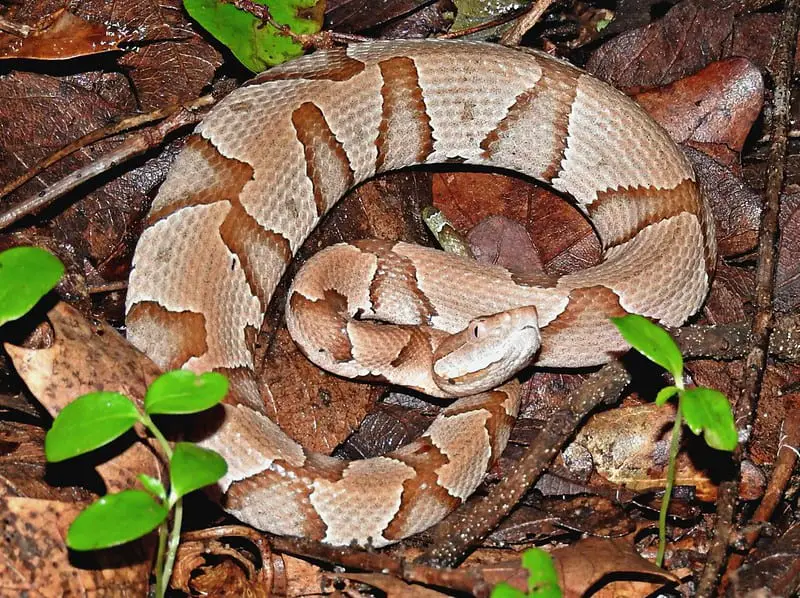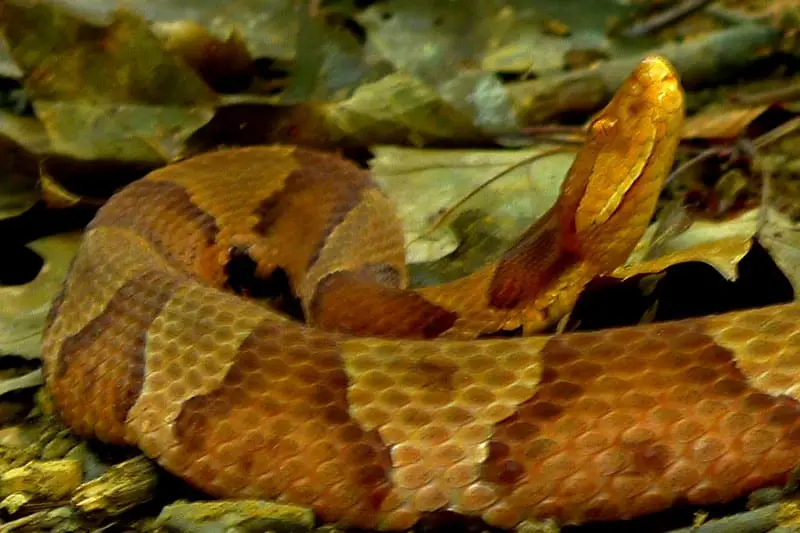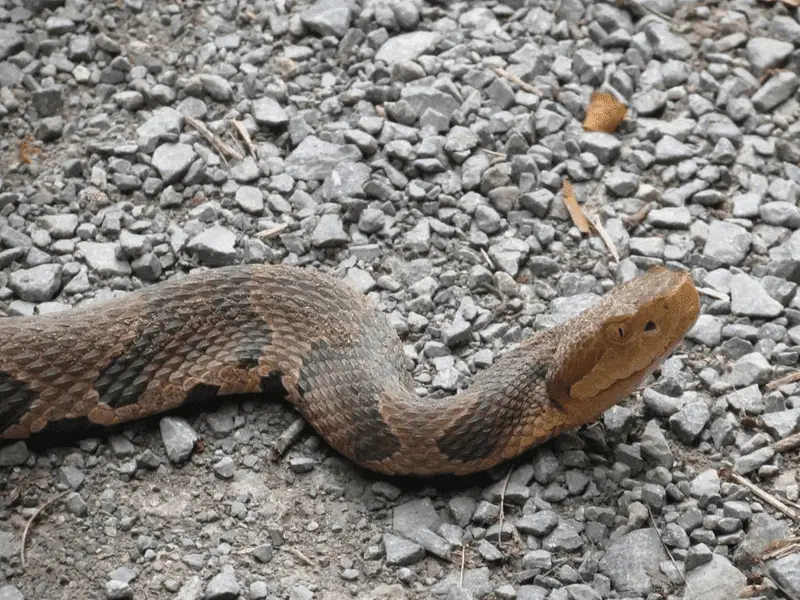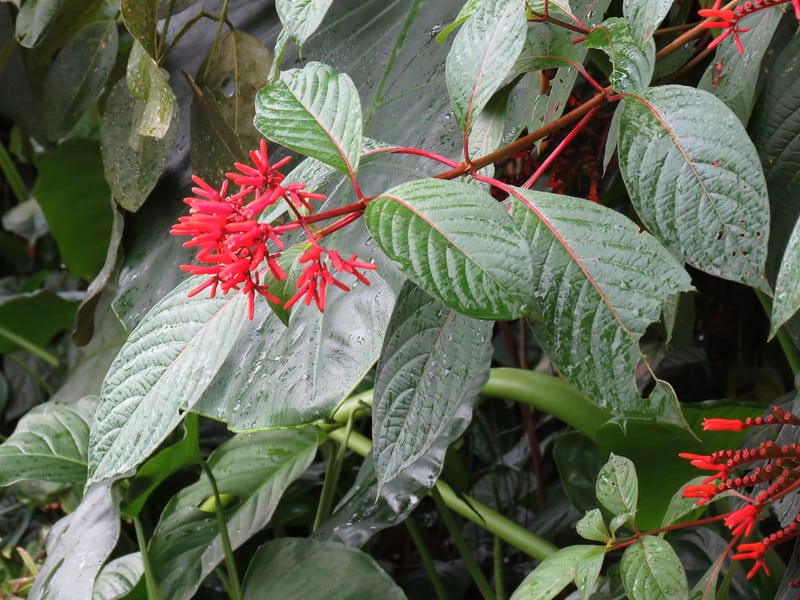We all know that Florida is home to a plethora of wildlife, but are there copperheads in the Sunshine State? This article will examine this question, discussing the presence of copperheads in Florida and what to look out for if you think you may have seen one.
The potential for spotting a copperhead in Florida can be exciting or even daunting, depending on your perspective. Keep reading to find out more about these slithering reptiles and whether they inhabit the state of Florida.
Everyone is eager to get outside and enjoy the nice weather during Florida’s spring season. But snakes also do. In Florida, there are 45 different types of natural snakes.
Only six of these are poisonous.
The eastern diamondback rattlesnake, timber rattlesnake, pygmy rattlesnake, copperhead, cottonmouth, and coral snake are among the poisonous species.
The two poisonous species with the most restricted ranges in Florida are copperheads and timber rattlesnakes. The state is home to the other four venomous species.
The majority of snake bites reported in the US have been attributed to copperheads. You can learn all there is to know about this dangerous species on this page, including where they dwell and how frequently they bite.
Copperheads in Florida
An adult copperhead’s total length ranges from 22 to 36 inches (56 to 91 cm), with males being larger than females. A few copper to tan color marks tinge the copperhead’s large, angular-appearing head.
The copperhead has a triangular form to its body, which is a colored light tan, brown, or reddish-brown with deeper brown and tan spots that are narrow at the top.
Their color pattern acts as camouflage by flawlessly blending with the leafy debris. Unless their tail tip is brilliant sulfur yellow, newborn copperheads resemble adults in appearance.
In Florida, how prevalent are copperheads?
Although they are not necessarily present across Florida, copperheads are exclusively present in the Florida Panhandle, primarily around the Apalachicola River and its tributaries.
From the Florida Museum’s herpetology collection, there are confirmed reports of copperheads from the counties of Escambia, Calhoun, Gadsden, Gulf, Liberty, Jackson, Santa Rosa, Leon, and Okaloosa.
Although there are no documented records from other Florida counties, the copperhead’s range may include the surrounding regions.

The copperhead snake is a species of pit viper that only lives in a small area of Florida’s northern panhandle, while its range spans the majority of the eastern United States.
The copperhead and canebrake rattlesnake is less common in Florida than the other six venomous snakes that live there.
In what parts of Florida do copperhead snakes reside?
In Florida, the copperhead prefers low-lying moist regions near streams, marshes, soggy ravines, and river bottoms. This species typically inhabits upland hardwood and pine woods that have a lot of leaf litter.
They frequently build their shelters out of huge logs, heaps of trash, and rocks. Sometimes you can discover copperheads in suburban areas when development is encroaching on their preferred habitats.
How Often Do Copperheads Bite?
Despite being the least toxic of the six venomous species in Florida, copperheads are a deadly species that are known to cause more snake bites than any other snake in the US. Despite the fact that copperhead snake bites are very painful, they are typically not fatal for healthy adults or medium-sized to big animals.
Children, the elderly, those in poor health, and tiny animals are more at risk.

A bite from a copperhead should be treated as a medical emergency, just like from a poisonous snake. Victims need to get emergency medical care from a doctor or a facility with experience treating snake bites.
Contrary to popular belief, copperheads are not hostile and prefer alone, avoiding direct contact.
Most copperhead bites occur when the snakes are intentionally approached or accidentally stepped on.
When are Copperheads Most Active in Florida?
In Florida, copperheads are most active from April to October. The number of recorded snake bites in the state increases throughout these months as temperatures rise.
Copperheads breed in the spring, from late February to early May, right after emerging from their winter burrows. During brumation, copperheads occasionally build nests with other snake species (hibernation).
In the sweltering summer months, they are nocturnal and actively prefer the cooler twilight hours for prey hunting. Copperheads enjoy cicada snacks, especially when they first emerge from their winter slumber to begin their quest for prey.
People in Florida may come into contact with copperheads more frequently than they would think during the spring because these cicada lovers are ravenous and ready.
Copperhead Defensive Behavior
To stay undetected, copperhead snakes mainly rely on their exceptional camouflage and nocturnal habits. They are almost never visible among the leaves and dirt because they are always properly disguised for defense.
These snakes display defensive responses when startled. They like to stand still and spread their ribs, making their bodies look as though they are flat against the ground.
When threatened, copperheads have been known to quickly vibrate their tail tips, emitting a buzzing sound, and discharge foul-smelling musk from glands at the base of their tails.
Although they make a buzzing noise similar to rattlesnakes, they shouldn’t be confused with those animals. Striking is a last-ditch measure of self-defense for copperheads.
How Do You Keep Copperhead Snakes Away?
Although it may be tempting, it is probably not a good idea to try to kill any snakes that come your way. If they are not disturbed, most snakes just pass by and do not want to harm anyone.
The majority of bites and attacks from snakes occur when people try to kill or pick them up.

Making the location unsuitable for snakes is the best approach to keep them away from your home or neighborhood.
Trim all tree limbs, hedges, and bushes, get rid of any low-hanging foliage and maintain your lawn as short as you can. You should keep an eye out for cicada season in Florida since that is when copperheads are most likely to emerge from hiding.
Cottonmouth vs. Copperhead
Due to their similar outward characteristics, copperheads and cottonmouths are frequently confused. Particularly young cottonmouths resemble copperheads in terms of their colors and patterns.
Keep an eye out for the dark crossbands on the bodies of these two snake species to tell them apart.
While young cottonmouths have numerous dark dots and speckles, the dark crossbands on the body of copperheads have none, or at most, one.
Adult Florida cottonmouths often have uniform black coloring and little perceptible patterning.
Also, observe how the copperhead lacks the cottonmouth’s dark facial band that covers the eye.
In conclusion, the answer to the question, “Are there copperheads in Florida?” is a resounding yes!
With its warm climate and ample habitat, the Sunshine State is home to several species of dangerous snakes.
While it’s important to be aware of these creatures and take precautions when outdoors, it’s also important to remember that most snake bites are preventable.
By following safety guidelines and respecting their habitats, we can all play a part in avoiding run-ins with Florida’s slithering residents.
From alligators to manatees, Florida has a lot of interesting and diverse animals. The good news is that there are indeed Copperheads in the state, although they can be difficult to find due to their secretive habits.
Now that you know this, why not try your luck and spot one?
Who knows, maybe you’ll be able to find one on your next adventure.








